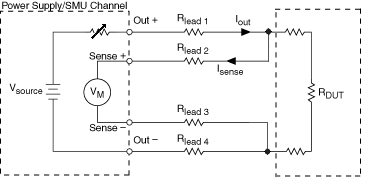Solution
Programming a positive output resistance allows you to simulate the output resistance of a non-ideal voltage source, such as a battery. The output resistance of a battery varies based on the type, age, charge, etc., and will cause a voltage drop at the output. You can program a positive output resistance with the SMU to reproduce this behavior and simulate the behavior of a battery.
These modules can also be programmed for negative output resistance. This is valuable when
remote sense connections cannot be connected directly to the DUT (Figure 1). This results in a series resistance between the remote sense connections and the DUT, which causes a voltage drop. You can program the output resistance to a negative value to nullify the effects of the voltage drop between the remote sense connections and the DUT.

Figure 1.
The supported programmable resistance ranges and accuracy values can be found in the
specifications document for each module.